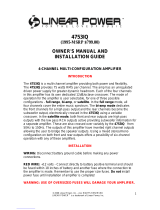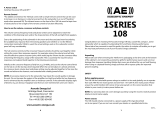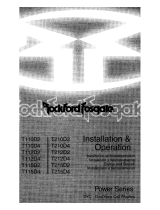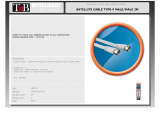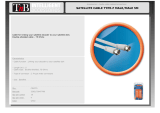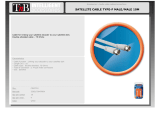Page is loading ...

Infinity Systems Inc.
250 Crossways Park Drive
Woodbury, N.Y. 11797
1-800-553-3332
A Harman International Company
Rev G 6/2001
BU-120/HTS-20
Powered Subwoofer
SERVICE
MANUAL

SAFETY INFORMATION
Warning
Any person performing service of this unit will be exposed to
hazardous voltages and the risk of electric shock. It is
assumed that any person who removes the amplifier from this
cabinet has been properly trained in protecting against
avoidable injury and shock. Therefore, any service
procedures are to be performed by qualified service personal
ONLY!
Caution
This unit does not have a power switch. Hazardous voltages
are present within the unit whenever it is plugged in.
Before the amplifier is plugged in, be sure its rated voltage
corresponds to the voltage of the AC power source to be
used. Incorrect voltage could cause damage to the amplifier
when the AC power cord is plugged in. Do not exceed rated
voltage by more than 10%: operation below 90% of rated
voltage will cause poor performance or may shut the unit off.
List of SafetyComponents Requiring
ExactReplacements
F1 Fuse SLO BLO 1.0A 250V 20mm.
UL approved
PWRCORD SPT-2 or better with polarized plug, UL
approved wired with the hot side to fused side.
Use with factory replacement panel strain relief
only.
T1 Transformer. Use only factory replacement.
DBR or D1 Bridge diode. Use only factory replacement.
C1, 2 4700uF, 50V electrolytic filter caps. Be sure
replacement part is at least the same working
voltage and capacitance rating. Also the lead
spacing is important. Incorrect spacing may
cause premature failure due to internal cabinet
pressure and vibration.
C6 10uF 50V electrolytic radial* BU120 and HTS-20 rev. A only.
S53AMI or CN1 Power output module. Use only factory
replacement
Faceplate Faceplate. Use only factory replacement
Air leak cover Use only factory replacement
CMC1 Use only factory replacement
L1 Use only factory replacement
Fuse PCB Use only factory replacement
Main PCB Use only factory replacement
R29 470Ω .25W METAL OXIDE, non flammable
Leakage/Resistance Check
Before returning the unit to the customer, perform a leakage
or resistance test as follows:
Leakage Current. Note there is no power switch on this unit.
When the power plug is plugged in, the unit is live. Connect
the unit to its rated power source. Using an ammeter,
measure the current between the neutral side of the AC
supply and chassis ground of the unit under test. if leakage
current exceeds 0.5mA, the unit is defective. Reverse the
polarity of the AC supply and repeat.
Resistance. Measure the resistance from either side of the
line cord to chassis ground. If it is less than 500k ohms, the
unit is defective.
WARNING! DO NOT return the unit to the customer if it fails
one of these tests until the problem is located and corrected.
2
Amplifier/Subwoofer BU-120/HTS-20
* See Service Bulletin (INF2000-01 REV 2) page 15.
IMPORTANT SERVICE NOTES: When testing the BU120/HTS-20 Series amplifier, a load must always be
connected to the output terminals, whether the woofer, or a 4 to 8 ohm resistive load.
All AC powered test instruments (meters, oscilloscopes, etc.) must have a floating ground, i.e. be
connected to an isolation transformer.

3
Amplifier/Subwoofer BU-120/HTS-20
GENERAL SPECIFICATIONS
Frequency Response (± 3dB) .................30Hz – 150Hz
Output (RMS).............................150W
Driver ..................................12"Woofer
Crossover Frequency .......................50Hz ~ 150Hz (continuously variable)
Dimensions (HxWxD).....................14½"(36.8cm) x 14 ½" (36.8cm) x14 ½" (36.8cm)
Add 1 ¾" (4.5cm) for feet.
Weight..................................43lbs/19.5 kg,
Refinements may be made on occasion to existing products without notice,
but will always meet or exceed original specifications unless otherwise stated.
TABLE OF CONTENTS
SAFETY INFORMATION...............................................................2
GENERAL SPECIFICATIONS.......................................................3
DETAILED SPECIFICATIONS ......................................................4
CONTROLS AND THEIR FUNCTION ..........................................6
BU-120/HTS-20 CONNECTIONS..................................................7
OPERATION ................................................................................11
BU-120/HTS-20 TEST SET UP AND PROCEDURE .................12
BU-120/HTS-20 POWER AMP MODULE
TESTING FLOW CHART ............................................................13
SERVICE BULLETIN INF9902 Rev 1 - FEBRUARY 2001 .........14
SERVICE BULLETIN INF2000-01 Rev 2 - FEBRUARY 2001 ....15
TECH TIPS .................................................................................16
BU-120/HTS-20 PACKING & CABINET ASSEMBLY................17
BU-120/HTS-20 AMPLIFIER ASSEMBLY
EXPLODED VIEW ......................................................................18
BU-120/HTS-20 rev. A PCB (revision 3.52)
Component Side Trace...................................................20
BU-120/HTS-20 rev. A PCB (revision 3.52)
Solder Side Trace...........................................................21
BU-120/HTS-20 rev. A PCB (revision 3.53)
Component Side Trace...................................................22
BU-120/HTS-20 rev. A PCB (revision 3.53)
Solder Side Trace...........................................................23
BU-120/HTS-20 ELECTRICAL PARTS LIST.................24
BU-120/HTS-20 IC DIAGRAMS .....................................25
BU-120/HTS-20 SCHEMATIC 1 of 2 .............................26
BU-120/HTS-20
HTS-20 REV B ELECTRICAL PARTS LIST
SCHEMATIC 2 of 2 .............................27
....................28
HTS-20 REV B SCHEMATIC...........................................33
HTS-20 REV B POWER AMP MODULE SCHEMATIC...34
HTS-20 REV B CIRCUIT BOARDS.................................31
REGARDING SERVICE FOR THE INFINITY HTS-20 SUBWOOFER
There are two versions, an "A" and "B", with minor internal differences.
Data for both versions is included, and differences noted in the following pages.
Units can be identified for service as follows:
Amplifier faceplate says "Made in Canada" on the "A" version.
Amplifier faceplate says "Made in China" on the "B" version.

DETAILED SPECIFICATIONS
LINE VOLTAGE Yes/No Hi/Lo
Line
Nom. Unit Notes
US 120vac/60Hz Yes 108-132 120 Vrms Normal Operation
EU 230vac/50-60Hz Yes 207-264 230 Vrms Normal operation, MOMS
required
Asia 100vac/50Hz No 90-110 100 Vrms Normal Operation
Parameter Specific
ation
Unit QA Test
Limits
Conditions Notes
Amp Section
Type (Class AB, D,
other)
D n/a n/a Class D Preferred...Sink
required for Class AB
Load Impedance
(speaker)
4 Ohms n/a Nominal Z-curve required
Rated Output Power 150 Watts 150 1 input driven
THD 0.3 % 1 22k filter 75w (Power Bandwidth
30-100Hz)
THD @ 1 Watt 0.5 % 0.8 22k filter
DC Offset 10 mV-DC 20 @ Speaker Outputs
Damping factor 100 DF 50
Input Sensitivity
Input Frequency 40 Hz Nominal Freq. 1 input driven
Line Input 63 mVrms ±2dB To Rated Power/ Vol @
Max
1 input driven: AP source
Z = 600 ohms
Speaker/Hi Level Input 4.8 Vrms ±2dB To Rated Power/ Vol @
Max
1 input driven: AP source
Z = 25 ohms
Signal to Noise
SNR-A-Weighted 100 dBA 90 Relative to rated output A-Weighting filter
SNR-unweighted 75 dBr 70 Relative to rated output 22k filter
SNR rel. 1W-unweighted 65 dBr 55 relative to 1W Output 22k filter
Residual Noise Floor 3 mVrms 4 Volume @max, using
RMS reading on A/P
22k filter required due to
100kHz switching noise
present at speaker output
Input Impedance
Line Input 10k ohms n/a Nominal
Speaker/Hi Level Input 200 ohms n/a Nominal
Filters 0dBr = 1w @ 50Hz
Low Pass (fixed or
variable)
Variable
Low Pass filter (point or
range)
50-150 Hz ±2dB -3dB Point
Slope 18-24 dB/Octav
e
n/a
Subsonic filter (HPF) 34 Hz ±2dB -3dB Point
Slope 24 dB/Octav
e
n/a
4
Amplifier/Subwoofer BU-120/HTS-20

Limiter (yes/no) yes
Max. Output
Power/THD=10%
150w/10
%
P
-max/TH
D
functional Maximum Output Power Maximum THD as a result
of limiting.
Features
Phase Switch (yes/no) yes — functional
Volume pot Taper
(lin/log)
linear — functional
Input Configuration —
Line In
(L,C,R,AC3,Mono)
L,R — functional
Enabled w/Line/Spkr Input Select Switch
Line Outputs (L,C,R) L,R — functional Buffered Output /
Pre-Volume control
Spkr/Hi Level In
(L,C,R,mono)
L,R — functional
Enabled w/Line/Spkr Input Select Switch
Spkr Out: Hi Pass Filter 100 Hz functional
8 ohm Satellite: 6dB/oct
passive xover
Driven from zero ohms
source impedance
Signal-Present LED Yes — — — Bi-Color LED
(green=signal/ red=no
signal)
Signal-Present Input
Freq.
100 Hz functional Nominal 200uF Series Cap on
PCB
Signal-Present Level 35 mV functional 100Hz into Line Input w/
1 ch. driven
Power on Delay time <2 sec. AC Power Applied
Transients/Pops
Turn-on/off Transient 500 mV-peak 2v-pp @ Speaker Outputs AC Line cycled from OFF
to ON or ON to Off
Efficiency
Stand-by Input Power 14 Watts @ nom. line voltage
Power Cons.@rated
power
110 Watts @ nom. line voltage
Efficiency 136% % Relative to rated output
Protection
Short Circuit Protection yes functional Direct short at output
Line
BU120
HTS-20
Fuse Rating 1.0 Amps Type-T or Slo Blo
Line Fuse Rating 2.0 Amps Type-T or Slo Blo
5
Amplifier/Subwoofer BU-120/HTS-20


When connecting your subwoofer make sure you turn
all the power off.
There are several ways to connect your subwoofer.
Read this section carefully to determine which method
is best suited for your installation.
The subwoofer may be fed directly with a low-level
signal taken from a preamplifier's output by using the
second set of output jacks on the rear of the
preamplifier (See Figure 1). If a preamplifier has only
one set of outputs, you may use two (2) “Y” connectors
(See Figure 2) to connect the subwoofer. Use
standard shielded leads terminated at each end with
male RCA connectors. Connect one end of each
stereo pair of leads to the preamplifier's left and right
outputs and connect the other end to the
corresponding left and right LOW-LEVEL INPUTS (1)
on the subwoofer.
If you are using a tube preamplifier and the connecting
leads will be longer than 10 feet (3 meters), we
recommend not using the above connection method. A
tube preamplifier may not be able to handle the
capacitance introduced by leads more than 10 feet in
length. Instead, try using the high-level connection
methods listed on pages 5-7.
Figure 1.
- A low-level signal can be used from a
preamp's output by connecting second set of
output jacks to the rear of your amplifier.
Figure 2.
- You can use this method (2“Y”
connectors) if your preamp has only one set
of outputs.
7
Amplifier/Subwoofer BU-120/HTS-20
BU-120/HTS-20 CONNECTIONS

When using a single subwoofer, you MUST use a pair of stereo low-level leads from your preamplifier's outputs. When using
two subwoofers, one for the left and another for the right channels, connect the left preamplifier output to BOTH the left and
right LOW-LEVEL INPUTS of the subwoofer used for the left channel by using a Female-to-Male “Y” connector at the
subwoofer's output. Connect the right-channel preamplifier output to both jacks of the right-channel subwoofer in the same
manner (See Figure 3). If the preamplifier has a mono subwoofer output, you'll also need a Male-to-Female “Y” connector to
split the mono signal to the subwoofer pair (See Figure 3).
Figure 3.
- Use this method when using a single subwoofer output or two subwoofers.
The subwoofer may be connected to your system using the
HIGH-LEVEL INPUTS (4) on the plate located on the rear
panel of the subwoofer. Use speaker wire, maintaining
proper polarity (+ to + and - to -). Attach the speaker wire to
the left and right HIGH-LEVEL INPUTS on the subwoofer
and the other ends to the proper left and right OUTPUTS on
your amplifier or receiver (See Figure 4).
If you plan to use two subwoofers (one for the left and the
other for the right channel), connect wires from the left and
right OUTPUT on your power amplifier or receiver and
attach the other ends to the corresponding HIGH-LEVEL
INPUTS on each subwoofer. Observe polarity (See Figure
4).
Figure 4.
- Use this method when using a single
subwoofer.
8
Amplifier/Subwoofer BU-120/HTS-20

Figure 5.
- Use this method when using two
subwoofers.
Figure 6.
- Use this method when connecting
one subwoofer to satellites.
Depending on whether you are using one or two
subwoofers, connecting your satellites can be
accomplished in one of two ways. If you are using a
single subwoofer with a pair of satellites, connect
them as shown in Figure 6.
9
Amplifier/Subwoofer BU-120/HTS-20

Figure 7.
- Use this method when
connecting two subwoofers to
satellites.
If you are using two subwoofers as a
stereo pair with a pair of satellites, connect
them as shown in Figure 7.
The subwoofer has a variable frequency
control that can be used to block unwanted
frequencies (between 50 - 150Hz) from
being reproduced by the subwoofer.
When you set this control depends on the
low-frequency capabilities of your satellite
speakers. Adjust this knob to the lowest
frequency that you satellite speakers were
designed to reproduce (refer to Operation,
step 7).
10
Amplifier/Subwoofer BU-120/HTS-20
HTS-20 - Has no external control. If you are
using a receiver or surround processor
containing a Dolby Digital and/or DTS
decoder, set the crossover bypass switch
to "On". If you are using a stereo or Dolby
Pro Logic receiver, set this switch to "Off";
this places the preset roll-off crossover
frequency point at 100Hz.
BU-120

OPERATION
Setting the Controls
Turn the Power On
4. Turn on the entire audio system and play any music
source.
5. Turn the Volume control to its mid position. If no sound
emanates from the subwoofer, check the AC line cord and
input cables. Are the connectors on the cables making proper
contact? Is the AC plug connected to a “live” receptacle?
Adjusting the Volume
6. Set the overall volume control of the preamplifier or stereo
to a comfortable level. Adjust the subwoofer's Volume control
until you obtain a pleasing blend of bass. Bass response
should not overpower the room but rather be adjusted so
there is a harmonious blend across the entire musical range.
Many users have a tendency to set the subwoofer volume too
loud following the belief that a subwoofer is there to produce
lots of bass. This is not entirely true. A subwoofer it there to
enhance bass, extending the response of the entire system
so the bass can be felt as well as heard. However, overall
balance must be maintained; otherwise, the music will not
sound natural. An experienced listener will set the volume of
the subwoofer so its impact on bass response is always there
but is never obtrusive.
The Crossover Frequency Controls (BU120
7. The Crossover Frequency control sets the high-frequency
roll-off, adjustable from 50 to 150Hz. Where you set this
control depends on the low-frequency capabilities of your
satellite speakers, system placement, and other factors
affecting the mid-bass region. Turn the control UP
(clockwise) until you feel there is too much mid-bass
information (around 100Hz), then back the control down a bit
until that area sounds more natural. To hear more low bass,
turn the Crossover Frequency control DOWN a bit and the
Volume control UP by about the same amount. This will
increase low bass while leaving the mid-bass sounding the
same as it did before the adjustment. To reduce low bass
without changing midbass, turn the Crossover Frequency
control UP and the Volume control DOWN. Switch the Phase
switch between “NOM” and “REV” positions while listening to
music. The selection that sounds the best is the correct
adjustment for your system.
Room Placement
8. The room placement of the subwoofer is the most critical
aspect of its installation. It will be necessary for you to try
various locations in your listening room before you choose
the final location. Some possible starting points include:
behind the right channel satellite speaker, along the back
wall between the satellites, along a side wall (but not too
close to a corner), or behind a couch or a chair.
In general, the closer the subwoofer is to wall and corners,
the greater the effect of low-frequency enhancement.
Experiment with the Crossover Frequency and Volume
controls in different locations until you are pleased with the
result you obtain from your particular application.
A Word of Advice
The Low-Frequency Roll-off and Volume controls may be
set anywhere within their rotation. However, it will be a most
unusual circumstance if you have to set the Volume control
completely clockwise. This may indicate an unbalanced
condition in your system (too much bass) or an especially
large room, or room placement may not be correct. Try
several other locations before concluding that the Volume
control must be set at maximum.
A Word About Tone Controls
The tone controls on your electronic components
(preamplifier, receiver, etc.) should be used with the utmost
discretion. Excessive boost can create severe power
demands on your power amplifier. Maximum bass boost
can create a demand for literally hundreds of watts in the
bass region, whereas in the “flat” position, or with the tone
controls switched out of the system, your average listening
level may be impressively and realistically loud at less than
10 watts. The remaining power capacity required is on
reserve for power peaks on sharp transients and powerful
crescendos.
11
Amplifier/Subwoofer BU-120/HTS-20
1. Initially set the subwoofer's Volume control to the minimum
position.
2. BU120 - Initially set the subwoofer's Crossover Frequency
control to 12 o'clock.
HTS-20 - If you are using a receiver or surround processor
containing a Dolby Digital and/or DTS decoder, set the
crossover bypass switch to "On". If you are using a stereo
or Dolby Pro logic receiver, set this switch to "Off"; this places
the preset roll-off crossover frequency point at 100Hz.
3. Set the subwoofer's Phase switch to the "0" position.
only)

NOTE: When testing the BU120/HTS-20 amplifier, a load must always be connected to the
output terminals, whether the woofer, or a 4 to 8 ohm resistive load.

13
Amplifier/Subwoofer BU-120/HTS-20
BU-120/HTS-20 POWER AMP MODULE TESTING FLOW CHART (HTS-20 rev. " A" only)

Infinity Systems, Inc. 250 Crossways Park Dr. Woodbury, New York 11797 (516) 496-3400
Service Bulletin
Service Bulletin INF9902 Rev1 - February 2001 This is considered a Minor repair
To: All Infinity Service Centers
Models: BU-80, BU-120, BU150, HTS-10, HTS-20
Subject: Check Solder Joints in Event of Failure
Some performance related complaints in the BU Series powered Subwoofers may be caused by cold solder
connections between the 28 pins of the Power Amp Module and the main circuit board. When troubleshooting,
failure to check these joints can result in erroneous conclusions or wasted time.
In the event you receive a Subwoofer with the complaints “Dead, or No Output, or Motorboating
(Oscillation)”, perform the steps listed below first before any further troubleshooting takes place:
1) Unplug all cables, lay the subwoofer on a padded surface.
2) Remove all Philips screws around the outer perimeter of the amplifier faceplate.
3) Remove amplifier assembly; you should be able to remove the amplifier far enough out of the cabinet to
service it without removing the woofer wires.
4) Locate the Power Amp Module; it is the large gray component with a metal case. On the solder side of the
circuit board are the 28 soldered connections to the Module.
5) Regardless of whether you can visibly see breaks in any of the connections or not, carefully re-solder all 28
pin connections, adding 60/40 rosin core solder. Take care not “bridge” any connections on the board with
solder.
6) Inspect the solder joints to the main filter capacitors C1 and C2 on the main PCB and re-solder if needed.
7) Replace the amplifier assembly back into the cabinet; replace the screws.
8) Test the unit by applying a signal from a music source, adjust the volume to a moderate level and confirm
the original problem has been corrected.
IMPORTANT SERVICE NOTES: When testing the BU or HTS Series amplifier, a load must always be
connected to the output terminals, whether the woofer, or a 4 to 8 ohm resistive load.
All AC powered test instruments (meters, oscilloscopes, etc.) must have a floating ground, i.e. be connected to
an isolation transformer.
14

Infinity Systems Inc. 250 Crossways Park Dr. Woodbury, New York 11797 (516) 553-3332
Service Bulletin
Service Bulletin INF2000-01 Rev2 - February 2001 Warranty labor rate: MINOR repair
To: All Infinity Service Centers
Models: BU80, BU120, HTS-10 revA, HTS-20 revA subwoofers
Subject: Failure of C6
In the event you receive a BU80, BU120, HTS-10 or HTS-20 subwoofer with the complaint “no output”
and capacitor C6 (10uf 50v NPE) is damaged in the amplifier:
Order kit Infinity part# 30722 and replace the following included parts:
C6 – (10uf 100v NPE cap) C24 – (100nF 50v cap) R46 – (47 1/4W resistor)
R23 – (20k 1/2W resistor – used only on models BU120, HTS-20 revA)
BU80/HTS-10 BU120/HTS-20
General reference for location only; not all parts or designators may conform to these drawings.
FOLLOWING THE REPAIR:
Follow instructions included in bulletin #INF9902.
IMPORTANT SERVICE NOTES: When testing the BU or HTS Series amplifier, a load must always be
connected to the output terminals, whether the woofer, or a 4 to 8 ohm resistive load.
All AC powered test instruments (meters, oscilloscopes, etc.) must have a floating ground, i.e. be connected
to an isolation transformer.
Models Serial number 120/230V Status Action
BU80
BU120
HTS-10 revA
HTS-20 revA
All serial numbers affected
Replace if damaged
Replace C6,R23, C24, R46
with
Infinity part# 30722
15

TECH TIPS
Troubleshooting tips and solutions to common service problems
For models: BU-120/HTS-20
TIP# INFTT2000-01
Complaint:
How do you replace or service any of the front panel components on the Subwoofer faceplate for model
BU-120/HTS-20.
Probable Cause:
The High level Input terminals, potentiometers, RCA jack, and switch(es) are behind a sealed cover to protect the
air-tight integrity of the cabinet enclosure.
Solution:
1) Unplug all external cables from the subwoofer; place the cabinet on a padded surface.
2) Remove any subwoofer grille; remove the woofer from the cabinet. Detach the two connections from the
woofer terminals.
3) Remove all Phillips screws holding the amplifier to the cabinet; remove the amplifier.
4) Remove all knobs, nuts, and Philips screws from the outer control section of the amplifier faceplate.
5) Locate the sealed cover on the inside of the amplifier faceplate (see illustration); the bead of adherent must be
broken to remove the main PCB with front panel components from the plastic faceplate. This is most easily
accomplished by CAREFULLY using a box cutter, exacto knife, or similar sharp instrument. First scrape all
excess material from the three surfaces; then force the blade into the groove between the rear cover and the
faceplate. DO NOT attempt to remove the rear cover from the main PCB.
6) When enough material is removed, the main PCB with cover should pull away from the faceplate, exposing
the components.
7) After servicing a bead of “silicon seal” or similar adherent must be applied to all surfaces where it was
removed. Reassemble the rest of the components in reverse order.
16
Amplifier/Subwoofer BU-120/HTS-20

17
Amplifier/Subwoofer BU-120/HTS-20
BU-120/HTS-20 PACKING & CABINET ASSEMBLY
NOTE: The HTS-20 subwoofer is part of the HTS-20 system and
packaged with 5 satellite speakers; the master carton is not shown.
SCREWS (4)
FEET
(SET OF 4)
#200310
SCREWS (8)
12" WOOFER
BU-120/HTS-10 (rev. "A" 200300
HTS-20 (rev. "B") 090-312000-000
CABINET
NOT FOR SALE
AMPLIFIER
ASSEMBLY
SCREWS (8)
TOP STYROFOAM
RAIL PADS
(2 per carton)
#200360
PLASTIC BAG
BOTTOM
STYROFOAM
RAIL PADS
(2 per carton)
#200360B
FEET PAD (4)
STICKERS
#200252
WARRANTY
CARD
#333715-001
OWNER'S MANUAL
BU-120 - #200230
HTS-20 - #HTS20GUIDE
CARTON
BU-120 - #200320
HTS-20 - #HTS20CTN
BU-120/HTS-20
CABINET ASSEMBLY
BU-120/HTS-20 PACKING
BU-120 or HTS-20
SUBWOOFER
00369

18
Amplifier/Subwoofer BU-120/HTS-20
BU-120/HTS-20 AMPLIFIER ASSEMBLY EXPLODED VIEW
E
E
D
D
C
C
B
B
A
A
7
7
6
6
5
5
4
4
3
3
2
2
1
1
BU-120/HTS-20
Amplifier Assembly
Exploded View
62018 6119
201819 20 6
HTS-20
BU-120

1 70170 #4x0.5" screws to secure input jacks 3
2 70171 #10 x 1" machine screw bolts for 4transformer 4 per unit 4
3 70172 #10 keps nuts for transformer 4
4 70173 #6 x 0.5" screws for fuse PCB 2
5 70301 Hum Shield Metal bracket mounted on transformer 1
BU-120 and HTS-20 rev "A" ONLY
5 073-014023-900 Hum Shield Metal bracket mounted on transformer 1
HTS-20 rev "B" ONLY
6 A70302 Volume Control/Crossover Knob 2/1
BU-120 and HTS-20 rev "A" ONLY
6 061-2-020000-000 Volume Control Knob 1
HTS-20 rev "B" ONLY
10 80110 T1 Transformer #4340 SAFETY PART 1
BU-120 and HTS-20 rev "A" ONLY
10 042-010028-001 T1 Transformer SAFETY PART 1
HTS-20 rev "B" ONLY
11 80111 F1 Fuse 250V, 1.0A, T type slo blo fuse SAFETY PART 1
BU-120 and HTS-20 rev "A" ONLY
11 091-000096-000 F1 Fuse 250V, 2.0A, T type slo blo fuse SAFETY PART 1
HTS-20 rev "B" ONLY
12 80105 Power cord, 2 conductor SAFETY PART 1
BU-120 and HTS-20 rev "A" ONLY
12 083-041802-017 Power cord, 2 conductor SAFETY PART 1
HTS-20 rev "B" ONLY
13 80106 Fuse PCB complete with connectors SAFETY PART 1
BU-120 and HTS-20 rev "A" ONLY
13 011-080203-000 Fuse PCB complete with connectors SAFETY PART 1
HTS-20 rev "B" ONLY
14 80112 Main PCB SAFETY PART 1
BU-120 and HTS-20 rev "A" ONLY
14 015-131700-101 Main PCB SAFETY PART 1
HTS-20 rev "B" ONLY
15 70303 Faceplate with labels SAFETY PART 1
16 A70304 Air leak cover SAFETY PART 1
17 70305 Pwr cord strain relief SAFETY PART 1
BU-120 and HTS-20 rev "A" ONLY
17 061-314002-000 Pwr cord strain relief SAFETY PART 1
HTS-20 rev "B" ONLY
18 108320 Dual RCA input jacks 1
BU-120 and HTS-20 rev "A" ONLY
18 072-010058-000 Dual RCA input jacks 1
HTS-20 rev "B" ONLY
19 108115 High level Input and Output terminals 1
BU-120 and HTS-20 rev "A" ONLY
19 062-050800-000 High level Input and Output terminals 1
HTS-20 rev "B" ONLY
20 70150 Phase Switch/Crossover bypass 1/2
BU-120 and HTS-20 rev "A" ONLY
20 074-030002-000 Phase Switch/Crossover bypass 2
HTS-20 rev "B" ONLY
Ref#
Part#
Description Qty

20
Amplifier/Subwoofer BU-120/HTS-20
Revision
3.52
-
Component
Side
T
race
Layer
5
5
4
4
3
3
2
2
1
1
A
A
B
B
C
C
D
D
E
E
F
F
G
G
BU-120/HTS-20 rev. A PCB (Component Side Trace)
/
